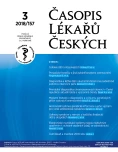Prenatal diagnostics of chromosomal aberrations in the Czech Republic: Actual data and important trends
Authors:
Antonín Šípek jr. 1,2; Vladimír Gregor 2,3,4; Antonín Šípek 2,4,5
Authors‘ workplace:
Ústav biologie a lékařské genetiky 1. LF UK a VFN v Praze
1; Oddělení lékařské genetiky, Thomayerova nemocnice, Praha
2; Katedra lékařské genetiky, Institut postgraduálního vzdělávání ve zdravotnictví, Praha
3; Sanatorium Pronatal, Praha
4; Ústav lékařské genetiky 3. LF UK, Praha
5
Published in:
Čas. Lék. čes. 2018; 157: 137-140
Category:
Original Articles
Overview
The main goal of this study was to analyse the spectrum of chromosomal aberrations that were diagnosed during prenatal diagnostics in the Czech Republic in 2016.
We present a retrospective epidemiological analysis that is based on the official data from the National Registry of Congenital Anomalies that is run by the Institute of Health Information and Statistics of the Czech Republic. Additional data were obtained actively from the departments of medical genetics and prenatal diagnostics under the guidance of the Czech Society of Medical Genetics and Genomics.
In 2016 there were 577 cases of chromosomal aberrations identified during prenatal diagnostics in the Czech Republic. The most important group of aberrations were the three main autosomal trisomies – Down, Edwards and Patau syndromes which were identified in 64.8 % of cases. The most frequent of them was the Down syndrome, that was identified in 271 cases (47 % of all cases identified in 2016). Other aberrations (including the abnormalities of the gonosomes and other autosomal anomalies) were still identified in more than one third of cases, although the screening programs do not primarily focus on them.
Combined screening in the first trimester and following prenatal diagnostics mostly identify main autosomal trisomies. Screening is currently the most important clinical referral for the invasive prenatal diagnostics procedures. We also observe important time trend of decreasing numbers of invasive diagnostics procedures – while the overall prenatal detection rate of chromosomal aberrations is not negatively affected.
Keywords:
hromosomal aberrations, prenatal diagnostics, prenatal screening
Sources
1. Beke A, Papp Z. Genetic components of perinatal morbidity and mortality. J Perinat Med 2001; 29 (3): 230–4.
2. McLaughlin ES, Schlosser BA, Border WL. Fetal diagnostics and fetal intervention. Clin Perinatol 2016; 43 (1): 23–38.
3. Hixson L, Goel S, Schuber P et al. An overview on prenatal screening for chromosomal aberrations. J Lab Autom 2015; 20 (5): 562–73.
4. Nicolaides KH. Screening for fetal aneuploidies at 11 to 13 weeks. Prenat Diagn 2011; 31 (1): 7–15.
5. Spencer K. Screening for Down syndrome. Scand J Clin Lab Invest Suppl 2014; 244: 41–7.
6. Loucký J, Springer D, Šubrt I. Doporučení o laboratorním screeningu vrozených vývojových vad v prvním a druhém trimestru těhotenství. Klin biochemie a metabolismus 2015; 23(44): 27–30.
7. Norton ME. First-trimester screening for chromosomal abnormalities: advantages of an instant results approach. Clin Lab Med 2010; 30 (3): 565–71.
8. Vanakker O, Vilain C, Janssens K et al. Implementation of genomic arrays in prenatal diagnosis: the Belgian approach to meet the challenges. Eur J Med Genet 2014; 57 (4): 151–6.
9. Drury S, Hill M, Chitty LS. Cell-free fetal DNA testing for prenatal diagnosis. Adv Clin Chem 2016; 76: 1–35.
10. Šípek A, Gregor V, Horáček J, Šípek A jr. National registry of congenital anomalies of the Czech Republic: Commemorating 50 years of the official registration. Cent Eur J Public Health 2014; 22 (4): 287–8.
11. Calda P, Šípek A, Gregor V. Gradual implementation of first trimester screening in a population with a prior screening strategy: population-based cohort study. Acta Obstet Gynecol Scand 2010; 89 (8): 1029–33.
12. Šípek A, Gregor V, Horáček J et al. Prevalence vybraných vrozených vad v České republice: vývojové vady ledvin, srdce a vrozené chromozomové aberace. Epidemiologie, mikrobiologie, imunologie 2013; 62 (3): 112–128.
13. Leoncini E, Botto LD, Cocchi G et al. How valid are the rates of Down syndrome internationally? Findings from the International Clearinghouse for Birth Defects Surveillance and Research. Am J Med Genet 2010, part A; 152A (7): 1670–80.
14. Cocchi G, Gualdi S, Bower C et al. International trends of Down syndrome 1993-2004: Births in relation to maternal age and terminations of pregnancies. Birth Defects Res A Clin Mol Teratol 2010; 88 (6): 474–9.
15. Alamillo CM, Krantz D, Evans M et al. Nearly a third of abnormalities found after first-trimester screening are different than expected: 10-year experience from a single center. Prenat Diagn 2013; 33 (3): 251–6.
16. Davis C., Cuckle H., Yaron Y. Screening for Down syndrome-incidental diagnosis of other aneuploidies. Prenat Diagn 2014; 34 (11): 1044–8.
17. Bedard T, Lowry RB, Sibbald B et al. Copy number variants and congenital anomalies surveillance: A suggested coding strategy using the Royal College of Paediatrics and Child Health Version of ICD-10. J Registry Manag 2016; 43 (1): 6–9.
18. Jírová J, Zvolský M, Šípek A. Národní registr vrozených vad jako rozvíjející se prostředek evidence nejen vrozených vad v České populaci. Neonatologické listy 2015; 21 (2).
Labels
Addictology Allergology and clinical immunology Angiology Audiology Clinical biochemistry Dermatology & STDs Paediatric gastroenterology Paediatric surgery Paediatric cardiology Paediatric neurology Paediatric ENT Paediatric psychiatry Paediatric rheumatology Diabetology Pharmacy Vascular surgery Pain management Dental HygienistArticle was published in
Journal of Czech Physicians

- Metamizole vs. Tramadol in Postoperative Analgesia
- Metamizole at a Glance and in Practice – Effective Non-Opioid Analgesic for All Ages
- What Effect Can Be Expected from Limosilactobacillus reuteri in Mucositis and Peri-Implantitis?
- Advances in the Treatment of Myasthenia Gravis on the Horizon
- Possibilities of Using Metamizole in the Treatment of Acute Primary Headaches
Most read in this issue
- Periodic fevers and other autoinflammatory diseases
- Lymph node syndrome associated with cat scratch disease in children and adults
- Celiac disease in children and adolescents
- A horizontal transmission of genetic information and its importance for development of antibiotics resistance
